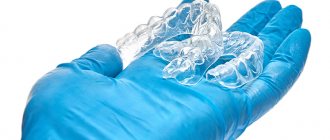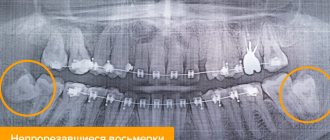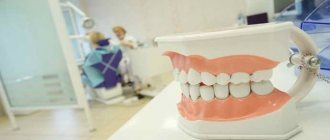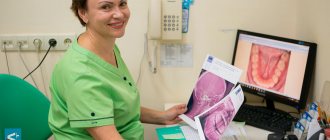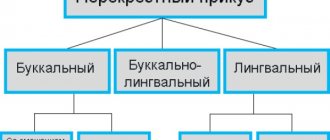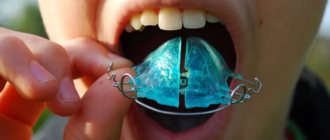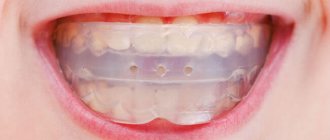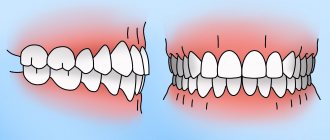Teeth aligners work in the same way as braces, but there are a number of differences. Mouthguards are removable structures that the patient independently removes and places back in the oral cavity. However, mouthguards look more aesthetically pleasing and do not cause discomfort when worn.
The psychological aspect of using mouthguards for a child: you need to explain to the child the need to wear the device, properly motivate the child for treatment - and then the process will not be difficult and “tearful”.
What are mouth guards for correcting bites?
Mouth guards are removable structures that fit over the teeth like a cover. They follow the shape of the dentition and are held in the oral cavity due to a very tight fit to the enamel surface. They are made according to an individual impression of the patient from elastic biosilicone or polyurethane. The thickness of the products is from 0.5 to 0.75 mm.
A corrective course requires a set of aligners from 12 to 25 pieces, which differ from each other by a slight change in geometric parameters. Products are numbered in order, and then during correction, in accordance with the numbering, are replaced. This causes the teeth to gradually move in a given direction and not move back to their original position. The orthodontist determines the exact number of aligners after performing a detailed diagnosis of a specific clinical case.
Indications for correcting malocclusion with mouthguards
It is obvious that it is impossible to correct all defects of the maxillofacial apparatus with the help of aligners. This course of therapeutic action is indicated in the following situations:
- crowded growth of teeth or their incorrect location on the jaw;
- diastemas and trema (increased spaces between dental units);
- malocclusion;
- defect in the development of the dental arch.
Indications for the need for correction using aligners are determined by the orthodontist of our dentistry during a consultation.
Flaws
Many parents believe that if they buy mouthguards to straighten their children’s teeth, they can solve any bite problems, including the most complex ones. Unfortunately, even top aligner manufacturers admit that significant defects, as well as open, distal, and mesial bites can only be corrected with the help of braces. Therefore, correction with mouthguards is possible only for minor malocclusions.
Another drawback concerns the discipline of wearing mouth guards. Individual children may remove the covers at school and only put them on in front of their parents. In this case, reasoned explanatory work is required, otherwise the effectiveness of treatment will be reduced to zero.
The price of aligners for children is higher than braces. This is especially true for products of famous brands. The average cost of a kit for the entire treatment period can reach up to 150,000 rubles.
Benefits of correcting your bite with mouthguards
- Efficiency. The positive result of therapy is due to the computer calculation of the parameters of the aligners in strict accordance with the characteristics of the clinical case.
- Wearing comfort. The aligners do not injure the mucous membranes of the cheeks and lips, as they have the smoothest possible surface. They can be removed and put on independently, without the help of a doctor.
- High degree of aesthetics. The appearance of the products does not cause rejection among children.
- There is no fastening elements and no need to apply an adhesive mixture to the enamel surface.
- Hypoallergenic. The material for making correctional products does not cause allergic reactions in the child.
- Possibility of use with other orthodontic structures.
- Short adaptation period.
- Quick restoration of diction.
- Easy to care for your mouth and aligners.
- No need to adhere to a special diet.
How is bite correction done in children using aligners?
- The orthodontist takes dental impressions of the child using silicone mass and an impression tray. The technique for taking impressions in children takes into account the natural mechanics of tooth movement. Impressions can be taken with a digital intraoral scanner. In this case, silicone mass is not needed.
- The doctor loads the obtained data into a computer program and creates a three-dimensional model of treatment (3D image), models each intermediate stage of correction and the result of treatment.
- After approval, the 3D model is sent to the laboratory, where an individual set of mouth guards is manufactured.
- Before installing mouth guards, the oral cavity is sanitized (plaque and stone are removed). The orthodontist attaches attachments - special composite fasteners that allow you to fix the aligners in the desired position. He puts on the first aligner, explains in detail the rules of wearing and care to the child and parents, issues a set of aligners for the first stage of correction, and sets a date for the next appointment.
Early correction of malocclusion makes it possible to use all the advantages of age and stop the formation of defects, preventing possible changes in the body aimed at compensating for dental pathologies. Correcting the bite with children's corrective mouthguards is not aimed at achieving ideal dentition aesthetics. It pursues other goals. The main task is to indicate the correct direction of growth and development of permanent teeth, creating conditions for the normal formation of the dental system.
Mouthguard Care
- The aligners must be washed with running water at least 2 times a day.
- The devices should be removed before eating and put on after eating, after cleaning them with a toothbrush and toothpaste.
- The correction structure should be stored in a special container with holes for ventilation. This will protect it from dust and other contaminants.
- For cleaning, use a regular brush and paste. You can also use special pharmaceutical products to care for dentures.
- It is necessary to clean the mouthguards from the inside and outside.
Important: aligners should not be boiled or washed in very hot water. This may cause them to become deformed. It is also not recommended to use abrasive detergents to avoid scratches.
Trainers
The orthodontic trainer can be used in children with primary and mixed dentition
.
The main feature of this device is its functional focus - in addition to a slight correction of the position of the teeth, the trainer effectively influences the formation of nasal breathing, the correct position of the tongue and lips, and eliminates the bad habits of putting the tongue between the teeth, sucking fingers and other objects.
How does the device work?
Silicone two-jaw mouth guard has platforms for the upper and lower dentition, a tongue guard and a lip bumper
.
When a child puts on a mouth guard, the teeth fit into special grooves and the jaw is fixed in the correct position. The tongue guard
prevents the tongue from being between the teeth, which prevents the development of an open bite, and the correct position of the tongue at the roof of the mouth contributes to the development of the upper jaw in length and width.
The lip bumper
ensures proper lip tone and closure and helps eliminate bad habits such as thumb sucking and mouth breathing.
In difficult clinical situations, the trainer is used as pre-orthodontic preparation (stage 1) for treatment with braces or aligners in the future, already permanent dentition (stage 2). The device eliminates bad habits, promotes the harmonious development of the jaws and proper teething, but does not ensure ideal straightness of permanent teeth and does not correct severe malocclusion pathologies.
What types of trainers are there?
Orthodontic trainers come in several standard versions. They differ in size, rigidity, frame, and can have areas for the entire dentition or separate cells for each tooth. The orthodontist selects the size and a specific model depending on the clinical case (LM-activator, Myobrace Starter, Myobrace NoCore, Elastopositioner-corrector, etc.)
When is a trainer appointed?
- bad habits (thumb sucking and other objects, breathing through the mouth, putting the tongue between the lips, etc.)
- slight crowding
- slight narrowing of the dentition
- reverse incisal overlap
- palatal or vestibular position of individual teeth
- Stage 1 of orthodontic treatment
The use of a trainer is contraindicated in case of impaired nasal breathing due to ENT pathologies (chronic runny nose, tonsillitis, etc.)
What is the wearing mode?
The device must be worn regularly and daily . The trainer must be worn at night, and during the day it is enough to wear the device for 2-3 hours, for example, while doing homework or watching TV. At first, the device may put a little pressure on your teeth or fall out of your mouth at night, but with regular use, adaptation occurs quite quickly - after just a week, the trainer will not cause any problems or discomfort. The trainer should not be chewed while being worn and you should not talk to it - this can deform the structure of the mouth guard and its impact will be unpredictable.
Using the trainer for 10 months
Caring for the device
The device must be washed under running water every time after use, and the mouth guard must be washed with soap once a week. The main thing is not to use very hot water and hard brushes, as this can damage the silicone material of the trainer and lead to its deformation.
Treatment of children using FlexiLigner aligners at the “Smile” dentistry
Dentists at the branches of our center use only reliable and proven technologies and devices to treat children. FlexiLigner aligners are one of them. The cost of therapy is from 350 thousand rubles. Treatment with KidsLight aligners costs from 90 thousand. This amount includes the manufacture of mouth guards, monthly visits to the doctor and retention devices.
The dental network offers affordable prices for orthodontic services, payment in installments during the course of correction, and a family discount when servicing several family members.
Our specialists regularly improve their professional status by studying in leading clinics in Russia and Europe. This allows us to offer world-class dental services to our patients.
The clinic has two branches in different areas of Moscow. You can choose the one that is more convenient for visiting:
- branch near the Alekseevskaya metro station (VDNKh area and Mira Avenue) at the address: st. 3rd Mytishchinskaya 3, building 2;
- Shelepikha metro station, address: Shelepikhinskaya embankment, 34, building 1.
It is within your power to make your child’s smile cheerful and beautiful, and to eliminate in advance the problems that he may encounter in the future. Come to our orthodontic centers, we can help you!
When are children's aligners needed?
You need to correct your child’s bite right away—in the first stages, all procedures are more effective and simpler. But usually parents come to the orthodontist after 12 years. A special feature of our clinic is that we treat occlusion without braces from the age of 7, that is, even the presence of baby teeth does not prevent us from planning treatment with aligners.
If you compare this bite mechanism and classic braces, then in the aligners you can see changes in the structure and position of the teeth in advance. The technique involves 3D scanning and already at the appointment you will be able to see the result - your future smile.
This can motivate the child well and add patience to him while wearing. After the appointment, the doctor will describe all the actual treatment methods, assessing the child’s personal characteristics.
Sign up for free 3D modeling of your future smile!
Make an appointment
*By making an appointment you consent to the processing of your data
Cases when wearing a mouth guard becomes necessary:
- you need to remove the gaps between the teeth;
- crowded teeth;
- incorrect alignment of the jaws;
- rotation of teeth in different directions;
- protruding jaw;
- The teeth in the row are positioned incorrectly.
A dental mouth guard for children can solve the same problems as braces. With one difference - they are more comfortable for the child.

